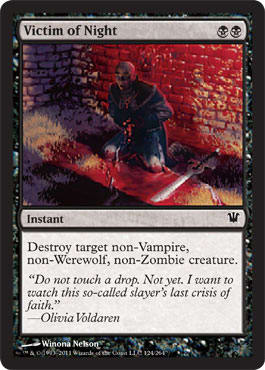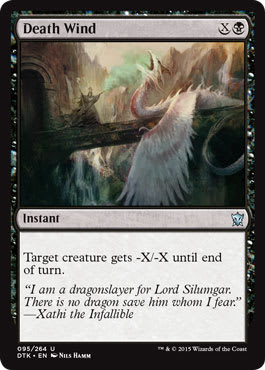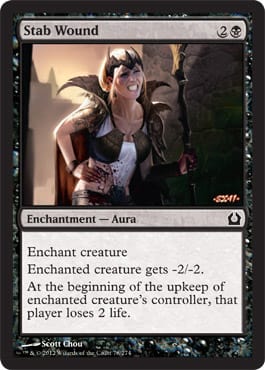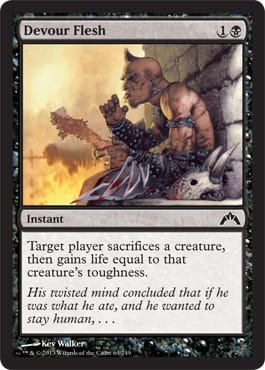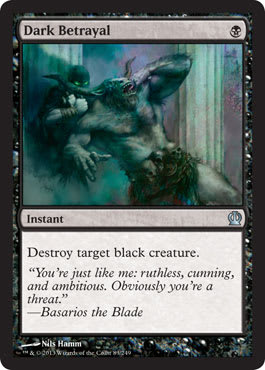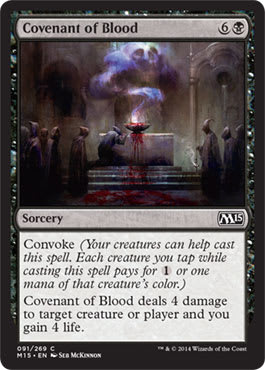Welcome to Eldritch Moon’s release week! In just a couple of days, Magic’s latest set will hit the market, and you’ll be able to start tuning your existing decks and building news ones. Perhaps you managed to take in a Prerelease, and got to play with the cards ahead of time. Perhaps you even got to Murder a creature or two!
Last week we kicked off a two-week history of modern-day Black removal, or at least removal of the single-victim variety (in other words, non-sweeper removal). In the previous article, we traced the history from Shards of Alara Black through Magic 2012. But before we continue, let’s take another look at the question of why this even matters.
To some, it won’t, and that’s okay. You enjoy the game that’s in front of you, and context, history, story, trajectory . . . all these things are for someone else to contemplate. That’s perfectly fine — being able to be accessible and interesting to a wide swathe of people is one of the secrets to Magic’s longevity.
But there are a great number of players who also enjoy a deeper appreciation for what makes the game what it is. To those people, the question, Why weren’t players opening up Murder in 1993? is a compelling one. It’s a bit like examining the Theory of Evolution. Why did we have Terror in ’93 but Murder in ’16? What were the environmental considerations that favored the selection of one versus another?
It certainly isn’t just a matter of changing up things to retain a sense of novelty and sell packs. Every card in a set has to fight with other cards for that spot, and a surprising amount of thought and consideration goes into each selection. Last week we highlighted one environment that needed a lot of sculpting, the “Battlecruiser Magic” of 2010’s Rise of the Eldrazi. In that set, players were asked to devote considerable resources toward putting all of their eggs in one basket — the massive Eldrazi.
To help guide players to do that, they had to make sure that players felt like they were getting value for their investment. If, say, they’d reprinted Doom Blade in the set, players would quickly abandon interest in the archetype after working all game to land a massive creature, only to see their opponent cackle, tap 2 mana, and wipe it aside.
Instead, we get removal like Vendetta, which forces its caster to brace for impact when aiming it toward an Eldrazi. We got a simple kill spell in Corpsehatch, which cost 5 mana and was a sorcery. Induce Despair, which could kill any Battlecruiser . . . provided you were playing with Battlecruisers, too! Black removal is just one cog in the machine, but sometimes looking at the role of a single cog can help illuminate the vision behind the whole.
Following Magic 2012, Black in-set removal remained somewhat diminished. Sure the Core Set had that modern-day Gold Standard, Doom Blade, but, with a few exceptions (Dismember, Go for the Throat), the writing was on the wall. Thanks to Phyrexian mana, Dismember could be jammed into any deck willing to pay 4 life to kill a threat, but in Innistrad things wouldn’t be so easy.
Innistrad Block (2011-12)
With the original Innistrad, released in September of 2011, removal options were fairly limited. Dead Weight was an enchantment-based option, which is a frequent card archetype. “It might not kill everything,” the reasoning goes, “but you can make nearly anything permanently weaker.” Tribute to Hunger was an Edict spell that let you gain life equal to the hapless creature’s toughness.
Then there was Corpse Lunge, a clunky bit of direct damage that was dependent upon the contents of your graveyard. Since one of the primary objectives of removal is to prevent things from having to go you your graveyard, it was a spell that played in somewhat cumbersome space: better in the late game, when things have died, but potentially at its best when it’s too late to actually impact the game. Of course, Innistrad had ways to cheat this, cards that helped ensure a full graveyard through self-milling. There was the potential for scoring with Corpse Lunge without having sustained any casualties whatsoever, but that didn’t change the fact that it was still contingent upon a certain set of circumstances to even be castable.
No surprise, then, that the pick of the litter here was Victim of Night. This had some flavorful exclusions, but that still left a wide range of eligible targets. And while, on the face of it, it only cost 2 mana, those 2 mana both had to be Black. That meant it wasn’t splashable, but rather was a card intended for decks already invested in the color — another price to pay.
Dark Ascension did little to change things. Like Corpsehatch, you had a five-mana sorcery in Death's Caress. The two spells make an interesting side-by-side, though. Corpsehatch, already a weak spell, at least gave you two 0/1 creatures that could be popped for mana. The Caress gave you lifegain, but only if your target was Human. While you could argue a worse baseline for removal than a five-mana, single-target removal spell, Death's Caress sure was close. The death mages of Innistrad sure could stand to learn a lot from some of their extraplanar counterparts.
The third set of the block, Avacyn Restored, was designed to stand alone as a large set. As a result, it offered up a full suite of Black removal. Like Rise of the Eldrazi, which was also a large, third set meant to be drafted on its own, the removal speaks volumes as to the environment that Wizards was trying to sculpt.
The similarities didn’t stop there. Although the Angels of Innistrad were no Eldrazi, the environment still wanted you to try your hand at dropping larger bombs. Any environment wanting to incentivize those sorts of returns by necessity had to have a down-powered removal slate.
The reprinting of Bone Splinters showed on its own that the environment wasn’t as all-in. You’d never have seen that card in Rise of the Eldrazi, given the prevalence of Eldrazi Spawn tokens. Here, sacrifice had to mean something, even if what your opponent was losing might have meant more. Beyond that, though, look at how conditional the removal was. Barter in Blood requires the sacrifice of two creatures beyond the actual card you’re playing, and even then, you don’t get to choose what your opponent sacrifices.
Ghoulflesh could barely be called removal, giving a mere -1/-1 debuff to its target. Grave Exchange is simply another Edict effect fused together with Raise Dead. Human Frailty? Surprise! It only hits Humans! Indeed, the most versatile removal in the rest of the pack is Death Wind- and the price for the versatility is mana.
Magic 2013 (2012)
Magic 2013, however, did bring about a few significant shifts. The most obvious of these was the replacement of the almost-too-good Doom Blade, with it replaced by Murder. Not only did Murder cost more, but by dint of it being ![]()
![]()
![]() instead of
instead of ![]()
![]() , it was harder to cast in addition to being more expensive than the go-to staple of Core Sets since Magic 2010, Doom Blade.
, it was harder to cast in addition to being more expensive than the go-to staple of Core Sets since Magic 2010, Doom Blade.
You also had Crippling Blight (another aura-based debuff), Essence Drain replacing Consume Spirit, and the interesting Public Execution. The latter might be more flexible than Murder, and at instant speed, but at 6 mana you might expect it to stand up and dance, too.
Return to Ravnica Block (2012-13)
From Avacyn Restored, we returned to familiar ground with Return to Ravnica. This marked a bit of a change, since multicolored could allow for more potent design. With the weaker removal in the last block, where would we go from here? As it turns out, a massive change in terms of quantity, but not quite so far in terms of quality.
In large part, that’s due to the nature of a multicolored block. In an ordinary set, you have mono-colored removal of five different types (representing the five colors of Magic). That means you can put them into any deck running that one color. In a multicolored set, where you’re looking to mine the design space generated by the intersection of colors, you have to have options for color pairs that can reasonably expect removal options. That’s naturally going to push the tally upward.
For many, the best option here was Ultimate Price, which targets only a mono-colored creature, but that says something about the environment, too. With plenty of multicolored creatures running around, how are they to be dealt with?
Well, there’s Assassin's Strike, which has a Stone Rain-y feel to it in that you have a basic effect with a tacked-on ability, driving up the cost. Launch Party destroys a creature, but you still have to sacrifice one of your own (trading creature for creature, and the card used to force the trade is itself traded for 2 life. Oh yea, plus the 4 mana you spent to make it happen). Then there’s Stab Wound, which is comparable to Dead Weight, but with an added “bleeder” effect of 2 life per upkeep. Interestingly, when you compare this to Dead Weight, you get an idea of exactly how much that effect is worth.
Thus far, these conditional removal spells have been mono-colored, but if you want the most lethal option for the cheapest cost, Auger Spree. This three-mana buff/debuff can strike down anything with 4 toughness or less at instant speed, but of course you must be playing both Black and Red to take advantage of it.
The follow-up set, Gatecrash, had to recreate the tableau. Both were large sets, meant to be drafted on their own, and each covered five of the guilds of Ravnica. Death's Approach covered the killing-by-aura angle, while Devour Flesh was another Edict effect, but the one also provided a glimpse of the environment. We’d just seen an Edict+lifegain card the block before, in Innistrad. Not only did it cost one more mana, but it could only be cast on your opponent. Devour Flesh not only opened up to be any player (yourself included) while returning the same lifegain and the same speed (instant), but it was even a common instead of an uncommon.
From there, you had options like Grisly Spectacle, which was a 4-mana instant with a milling component, with the flavorful caveat that it was useless against artifact creatures. Killing Glare was the latest iteration of X-spell removal, following in the footsteps of Death Wind, only with less versatility since this one is “all or nothing” while Death Wind could be used as a debuff if you didn’t have mana enough for an outright kill. And then you had your multicolored options, and more of them than you had in Return to Ravnica. Both Dimir Charm and Orzhov Charm had a removal option, albeit narrow or conditional ones. Finally, One Thousand Lashes offered you a Pacifism with a sinister twist, a steady bleeding of life.
If you thought things might slow down in the final set, the small Dragon’s Maze, you’d be mistaken. Instead, the set doubled down on multicolored removal. The Rakdos got two spells, both of them very conditional. Morgue Burst was a card out of the removal+recursion design space, last seen with Grave Exchange. In this case, it wasn’t outright destruction, but rather damage based on what was returned. Showstopper, meanwhile, grants every one of your creatures a death trigger that lets them deal 2 damage to an opponent’s creature. That makes it extremely narrow. You need to see multiple creatures die in order to take down a larger threat across the table, but it certainly conveyed the hell-is-a-carnival atmosphere the guild was going for in this latest iteration.
The other guild picking up two options was the Golgari, another guild with a Black component. Drown in Filth is a very modest sorcery, giving a creature -1/-1 for each land in your graveyard after letting you mill off four. On the other hand, the Golgari also got the reprinted Putrefy, one of the strongest removal cards in the block. For just 3 mana, it could solve almost any creature or artifact, and with an anti-regeneration clause tacked on to boot. Of course, it required the playing of the correct colors of mana, but that’s to be expected in a set that’s pushing you to do just that.
The last multicolored option was Warped Physique, which played in the same space that Death Wind did, but with the twist that it could be used to boost power rather than diminishing it. If you were looking for mono-colored options, your pickings were comparatively paltry: an Edict effect in Far // Away, and the debuff Fatal Fumes.
Magic 2014 (2013)
Look who’s back! After taking a year off, Doom Blade came back to the Core Set scene. Simple, powerful, and effective, this time around it was bumped up in rarity to uncommon, so there would be less of them sloshing around the draft tables. Wring Flesh was back after a sabbatical as well, and Corrupt and Quag Sickness rotated back in after a two-year one.
In addition to the reprints, two new spells saw their origin here: Liturgy of Blood (pricey removal that refunded you a Dark Ritual), and Artificer's Hex. The Hex was more of an anti-Equipment card than actual removal, because you could cast it and it would never destroy anything. It would, however, make your opponent think twice before using it. Job done!
Theros Block (2013-14)
After the heavy traffic in removal found in Return to Ravnica block, things went back to normal with Theros. While it’s interesting to note that Theros had the same number of Black removal cards as Return to Ravnica, Theros represented a return to the traditional block structure of the day, a large set followed by two small sets, and would overall have a lot less to offer in terms of quantity of cards.
Not only that, but Sip of Hemlock set the tone early: removal would again come at a dear cost. The Sip was a six-mana sorcery, and the modest life-loss rider hardly seemed worth the cost. Of course, beggars can’t be choosers, and sometimes you just have to make do. After all, what was left? Lash of the Whip was a -4/-4 debuff, an effect that not long ago (Scars of Mirrodin) cost two Black mana. Now it cost five (exactly what you’d pay, by the way, if you’d used a Death Wind for the same effect). Viper's Kiss was just a comparative nudge at -1/-1, albeit a nudge that shut down activated abilities. Pharika's Cure was a reskinned Sorin's Thirst, which itself was just a sped-up Vicious Hunger. Finally, Dark Betrayal was everything you’d want in removal, except it only targeted Black creatures.
As mentioned above in the context of Rise of the Eldrazi, removal can tell you a lot about its environment. In that set, “Battlecruiser Magic” needed soft removal to thrive, otherwise players wouldn’t buy in to the concept. It’s surely no coincidence that Theros offered an environment where players were asked to place a lot of eggs in one basket, thanks to monstrous. To let creatures shine, sometimes you have to make their workplace a little safer.
Born of the Gods added little to change that. Asphyxiate was heavy Black removal that only worked on untapped creatures, so if you were trying to destroy an offensive threat, you had a very narrow window of opportunity. Eye Gouge was a flavorful piece of anti-Cyclops tech, while Weight of the Underworld was a slightly stronger Wring Flesh.
Clearly the pick of the litter, then, was Bile Blight, which saw constructed play. Bile Blight’s removal powers are actually somewhat modest, only hexing for -3/-3. Of course, the ability to destroy multiple creatures for one card is exactly the kind of value constructed play loves, and it was also a useful answer to the gaggles of token creatures left behind in the wake of Return to Ravnica block.
Journey into Nyx rounded things out with Feast of Dreams, a narrow bit of removal that had some useful application in a set filled with auras and enchantment creatures. Nightmarish End was another –X/-X variant, but one whose power level was tied to the number of cards in your hand. Nyx Infusion was also tied in with the enchantment creature theme, being a two-way card that offered both a bane and a boon, depending on the qualities of the target. Finally, Spiteful Blow was an interesting bookend to Sip of Hemlock, as each provided removal and an additional effect at the same cost (in this case, land destruction).
Magic 2015 (2014)
Magic 2015 marked a fairly stark break from the patterns of Core Sets previous. In the past, we’d seen certain cards “rotate” in and out of the Core Set environment, but Magic 2015 seemed to want to be its own set. None of the removal from Magic 2014 was retained, and only Crippling Blight had seen printing in any previous Core Set.
Instead, we got Covenant of Blood, a new spell taking advantage of the set’s returning mechanic, convoke, which is a substantial amount of direct damage. Flesh to Dust is an outright kill spell in the classic sense (right down to the anti-regeneration rider), but it’s one that costs 5 mana.
On the other hand, there are some fairly aggressive options here, too. It’s not all bad news. Ulcerate is a superbly affordable debuff, just 1 mana for -3/-3. Oh, and maybe a little life loss, too. Stab Wound, brought back from Return to Ravnica, might not outright kill most creatures, but it can certainly get a nettlesome defender out of your way. This is a fairly reasonable removal suite, even if the price tag for instant kill itself was back to its post-inflationary level. But then, removal was never really a problem for the Core Sets, where Doom Blade had dwelled far more often than not. Core Sets were like an oasis, a place of calm, a refuge from the forces battering and buffeting removal from one form to the next.
Theros block was not a good year for fans of cards that kill creatures. In just a few short years, we’d gone from seemingly evergreen Doom Blades, cheap debuff removal like Disfigure or Grasp of Darkness (seeing its ultimate realization in Dismember), and outright death in Dark Banishing and Smother, toward an era of more narrow and conditional removal beginning with Innistrad.
Join us next week when we conclude our walk through history, and see where Eldritch Moon rests on the removal spectrum. The original Innistrad marked a downturn for these types of cards. Is redemption on its way . . . or only more madness?















